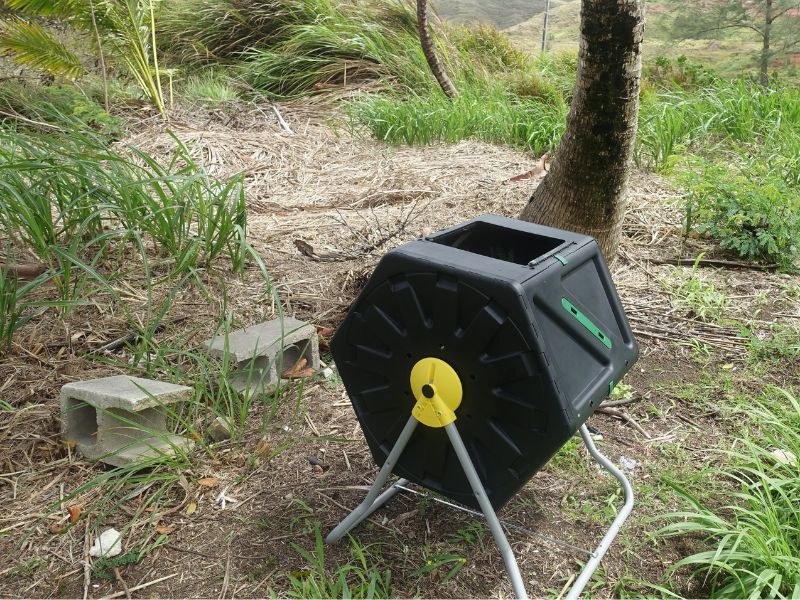How Do Tumbler Compost Bins Work?

Tumblers are composting bins that are manually flipped, spun, rolled or crank-turned for aeration, depending on the style. These bins do not require turning with a pitchfork or auger, instead, the entire compost bin is turned for aeration.
There are several variations on this theme.
Spinning Tumbler
This tumbler is spun around a central axis. This tumbler is loaded through the sliding side panel and sits very low to the ground. It spins around a central axis like a hamster running wheel. This one holds about 56 gallons of raw materials, it has 2 separate chambers.
Pros: It is easily filled and emptied. The smaller size means it doesn’t get as heavy, making it easier to tumble.
Cons: It does not hold a large amount of material; there is not enough materials needed to create a “hot” pile. It requires a bent position to turn.
Crank Tumbler
This tumbler is turned by cranking the handle. This tumbler also has 2 chambers, but it can hold up to 25 cu ft or 186 gallons of raw material. To aerate, the handle is turned using a geared system. This bin costs almost $600.
Pros: It can hold a large volume of materials. The 2 bins allow for composting at variable stages (you can add fresh material to one side, but add no new material to the side that needs time to finish processing). It is reasonably easy to empty, using gravity and a wheelbarrow. The doors can be removed completely and independently.
Cons: It is not so easy to fill– material has to be lifted up into the barrel. When the barrel is full, cranking becomes quite difficult, even with the gears!
Roller Tumbler
This tumbler is rolled like a ball. The lid of this tumbler spins and unlocks so material can be loaded inside. The tumbler can then be rolled like a ball for aeration.
Cons: Because it is not completely round, it does not roll on a straight path. It can be difficult to empty, and it would not good for someone with back problems. We had one that was donated to the Center and we test-drove it at a Master Composter course. The top kept popping off—we ended up bungee’ing and wiring, etc. to make it stay on.
Pros: It is easily filled and can be fun for kids to roll!
Central Axis Flipped Tumbler
This tumbler is flipped on its central axis. These tumblers are loaded through the top. Some models have an aeration tube going down the center. The tumbler is flipped around its central axis for aeration. Prices vary from $100 – 300 depending on quality of construction.
Pros: I read a prior review which stated, “The center axle doubles as a mixer, blending the materials inside the tumbler.” I have never seen this to be the case. I have to say I have no pros to contribute. At home, I ended up using the one that was given to me to store tools in.
Cons: It is difficult to load and even more difficult to unload. It is REALLY tough to turn when full, often requiring more than one person. We had a unit similar to this at the Center and its lid warped. Because we could not fit the lid back on, the tumbler became completely unusable.
There are other various models of tumblers out on the market. Remember to do your research and read reviews before purchasing a tumbler. Pay close attention to door hinges and closures because if you cannot close the compost bin, it cannot be tumbled. Consider loading AND unloading the bin. Think about how the bin when tumble when full. The featured small 56 gallon tumbler could weigh almost 400 lbs when full!
Tumbler composters present users with advantages and disadvantages. We’ve provided an overview of their pros and cons to help you decide if a tumbler composter is right for your space and lifestyle!
Overall Tumbler Pros:
There is no pitchfork required to turn a tumbler. When you turn a tumbler, all the material is getting turned at the same time, not by shovelful, like a compost pile would be turned, resulting in a nice homogenous mix with even decomposition. A backyard is not required to own a tumbler; it can be placed on a patio or in a garage because it does not need to sit on dirt. Tumblers close tightly so one of the greatest advantages of a tumbler system is that they can truly keep out unwanted 4-legged critters. School gardens tend to favor this style for this reason. And, with routine turning, tumblers can make compost fairly quickly.
Overall Tumbler Cons:
Generally, we’ve found that once a tumbler is full, the weight of the material makes it difficult to turn (on the pro side, you’ll definitely be getting a good workout!). Depending on the model, but especially if the opening is not near the ground, tumblers can also be difficult to load or unload. We used one at a school recently and the lid (which could not be removed) kept hitting us in the head while emptying it! Lastly, because tumblers do not sit on the ground, it is unlikely that beneficial insects and/or worms will find their way into the bin to help with the decomposition process.
Solana Center has several tumbler models at our compost demonstration site – please feel free to drop by during our open hours to explore some options!
